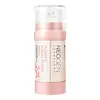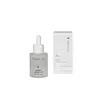What's inside
What's inside
 Key Ingredients
Key Ingredients

 Benefits
Benefits

 Concerns
Concerns

 Ingredients Side-by-side
Ingredients Side-by-side

Water
Skin ConditioningLactobacillus Ferment Lysate 21%
Skin ConditioningIsopentyldiol
HumectantTriethylhexanoin
MaskingPropanediol
Solvent1,2-Hexanediol
Skin ConditioningNiacinamide
SmoothingButylene Glycol
HumectantAcrylates/C10-30 Alkyl Acrylate Crosspolymer
Emulsion StabilisingEthylhexylglycerin
Skin ConditioningXanthan Gum
EmulsifyingTromethamine
BufferingAdenosine
Skin ConditioningGlycerin
HumectantBetaine
HumectantAllantoin
Skin ConditioningTrehalose
HumectantPanthenol
Skin ConditioningLavandula Angustifolia Oil
MaskingCitrus Aurantium Bergamia Fruit Oil
MaskingCitrus Aurantium Dulcis Peel Oil
MaskingAniba Rosaeodora Wood Oil
AstringentRosmarinus Officinalis Leaf Oil
MaskingEucalyptus Globulus Leaf Oil
PerfumingBifida Ferment Lysate
Skin ConditioningXylitol
HumectantJuglans Regia Seed Oil
Skin ConditioningLactic Acid
BufferingUndaria Pinnatifida Extract
Skin ConditioningStreptococcus Thermophilus Ferment
HumectantHoney Extract
HumectantSodium PCA
HumectantSodium Lactate
BufferingCaprylic/Capric Triglyceride
MaskingGlyceryl Caprylate
EmollientArginine
MaskingAspartic Acid
MaskingPCA
HumectantPhospholipids
Skin ConditioningGluconic Acid
Ceramide NP
Skin ConditioningGlycine
BufferingAlanine
MaskingMusa Sapientum Fruit Extract
Skin ConditioningTuber Melanosporum Extract
HumectantDaucus Carota Sativa Root Extract
Skin ConditioningSerine
MaskingValine
MaskingCholesterol
EmollientIsoleucine
Skin ConditioningThreonine
Proline
Skin ConditioningTuber Magnatum Extract
Skin ConditioningPhenylalanine
MaskingHistidine
HumectantPhellinus Linteus Extract
Skin ConditioningGlutathione
Hyaluronic Acid
HumectantBeta-Glucan
Skin ConditioningPhytosterols
Skin ConditioningHydrolyzed Hyaluronic Acid
HumectantSodium Hyaluronate
HumectantLimonene
PerfumingLinalool
PerfumingCetyl Ethylhexanoate
EmollientCoco-Caprylate/Caprate
EmollientPolyglyceryl-10 Laurate
Skin ConditioningCarbomer
Emulsion StabilisingCoptis Japonica Extract
AntimicrobialDextrin
AbsorbentTheobroma Cacao Extract
Skin ConditioningHydrolyzed Collagen
EmollientSqualane
EmollientPolydecene
Skin ConditioningOlea Europaea Fruit Oil
MaskingAdansonia Digitata Seed Oil
EmollientHydrogenated Lecithin
EmulsifyingAcacia Senegal Gum
MaskingAgar
MaskingRoyal Jelly Extract
Skin ConditioningPropolis Extract
Skin ConditioningArtemisia Capillaris Extract
Guaiazulene
AntimicrobialTocopheryl Acetate
AntioxidantCeramide Ns
Skin ConditioningCeramide As
Skin ConditioningCeramide EOP
Skin ConditioningCeramide AP
Skin ConditioningCopper Tripeptide-1
Skin ConditioningAcetyl Hexapeptide-8
HumectantTripeptide-1
Skin ConditioningPalmitoyl Tetrapeptide-7
Skin ConditioningPalmitoyl Tripeptide-1
Skin ConditioningPalmitoyl Pentapeptide-4
Skin ConditioningHexapeptide-9
Skin ConditioningTripeptide-2
Skin ConditioningNonapeptide-1
Skin ConditioningHexapeptide-11
Skin ConditioningWater, Lactobacillus Ferment Lysate 21%, Isopentyldiol, Triethylhexanoin, Propanediol, 1,2-Hexanediol, Niacinamide, Butylene Glycol, Acrylates/C10-30 Alkyl Acrylate Crosspolymer, Ethylhexylglycerin, Xanthan Gum, Tromethamine, Adenosine, Glycerin, Betaine, Allantoin, Trehalose, Panthenol, Lavandula Angustifolia Oil, Citrus Aurantium Bergamia Fruit Oil, Citrus Aurantium Dulcis Peel Oil, Aniba Rosaeodora Wood Oil, Rosmarinus Officinalis Leaf Oil, Eucalyptus Globulus Leaf Oil, Bifida Ferment Lysate, Xylitol, Juglans Regia Seed Oil, Lactic Acid, Undaria Pinnatifida Extract, Streptococcus Thermophilus Ferment, Honey Extract, Sodium PCA, Sodium Lactate, Caprylic/Capric Triglyceride, Glyceryl Caprylate, Arginine, Aspartic Acid, PCA, Phospholipids, Gluconic Acid, Ceramide NP, Glycine, Alanine, Musa Sapientum Fruit Extract, Tuber Melanosporum Extract, Daucus Carota Sativa Root Extract, Serine, Valine, Cholesterol, Isoleucine, Threonine, Proline, Tuber Magnatum Extract, Phenylalanine, Histidine, Phellinus Linteus Extract, Glutathione, Hyaluronic Acid, Beta-Glucan, Phytosterols, Hydrolyzed Hyaluronic Acid, Sodium Hyaluronate, Limonene, Linalool, Cetyl Ethylhexanoate, Coco-Caprylate/Caprate, Polyglyceryl-10 Laurate, Carbomer, Coptis Japonica Extract, Dextrin, Theobroma Cacao Extract, Hydrolyzed Collagen, Squalane, Polydecene, Olea Europaea Fruit Oil, Adansonia Digitata Seed Oil, Hydrogenated Lecithin, Acacia Senegal Gum, Agar, Royal Jelly Extract, Propolis Extract, Artemisia Capillaris Extract, Guaiazulene, Tocopheryl Acetate, Ceramide Ns, Ceramide As, Ceramide EOP, Ceramide AP, Copper Tripeptide-1, Acetyl Hexapeptide-8, Tripeptide-1, Palmitoyl Tetrapeptide-7, Palmitoyl Tripeptide-1, Palmitoyl Pentapeptide-4, Hexapeptide-9, Tripeptide-2, Nonapeptide-1, Hexapeptide-11
Water
Skin ConditioningAloe Barbadensis Extract
Skin ConditioningHamamelis Virginiana Extract
AntiseborrhoeicSodium Citrate
BufferingNiacinamide
SmoothingRosa Damascena Flower Water
MaskingGluconolactone
Skin ConditioningSodium Benzoate
MaskingSodium Hyaluronate
HumectantDimethyl Sulfone
SolventPanthenol
Skin ConditioningPalmitoyl Oligopeptide
CleansingPalmitoyl Tetrapeptide-7
Skin ConditioningPalmitoyl Tripeptide-5
Skin ConditioningPalmitoyl Tripeptide-38
Skin ConditioningAcetyl Hexapeptide-8
HumectantArginine
MaskingCarnitine
CleansingCarnosine
Skin ConditioningGlycine
BufferingHistidine
HumectantLysine
Skin ConditioningProline
Skin ConditioningPotassium Sorbate
PreservativeGlycyrrhiza Glabra Root Extract
BleachingChamomilla Recutita Flower Extract
MaskingAdenosine
Skin ConditioningSodium Phytate
Water, Aloe Barbadensis Extract, Hamamelis Virginiana Extract, Sodium Citrate, Niacinamide, Rosa Damascena Flower Water, Gluconolactone, Sodium Benzoate, Sodium Hyaluronate, Dimethyl Sulfone, Panthenol, Palmitoyl Oligopeptide, Palmitoyl Tetrapeptide-7, Palmitoyl Tripeptide-5, Palmitoyl Tripeptide-38, Acetyl Hexapeptide-8, Arginine, Carnitine, Carnosine, Glycine, Histidine, Lysine, Proline, Potassium Sorbate, Glycyrrhiza Glabra Root Extract, Chamomilla Recutita Flower Extract, Adenosine, Sodium Phytate
Ingredients Explained
These ingredients are found in both products.
Ingredients higher up in an ingredient list are typically present in a larger amount.
Acetyl Hexapeptide-8, commonly known as Argireline or Acetyl Hexapeptide-3, is a popular peptide in skincare. It’s often referred to as a “Botox-like” ingredient because it helps reduce muscle movement.
By relaxing these micro-movements, Argireline may help minimize the appearance of fine lines and wrinkles. That said, it’s not as powerful as Botox, and research on its long-term effectiveness is still limited.
Beyond smoothing, Argireline may also support collagen production. Collagen is the protein that helps keep your skin firm, bouncy, and well-hydrated by strengthening the skin barrier.
So while Argireline isn’t a miracle fix, it can be a helpful addition to a routine focused on both prevention and skin health.
Read more about other common types of peptides here:
Learn more about Acetyl Hexapeptide-8Adenosine is in every living organism. It is one of four components in nucleic acids that helps store our DNA.
Adenosine has many benefits when used. These benefits include hydrating the skin, smoothing skin, and reducing wrinkles. Once applied, adenosine increases collagen production. It also helps with improving firmness and tissue repair.
Studies have found adenosine may also help with wound healing.
In skincare products, Adenosine is usually derived from yeast.
Learn more about AdenosineArginine is an amino acid that is important for human development. Your body uses is it to produce hair keratin and skin collagen.
As a cosmetic ingredient, Arginine has antioxidant properties and can also help repair damaged skin. This ingredient is derived either synthetically or from animals.
Arginine isn't fungal acne safe when used in the presence of other lipids (fats, fatty acids, oils, esters, etc). Oils and fats occur naturally within the skin, so take caution when using Arginine if you're prone to fungal acne.
Learn more about ArginineThis ingredient is an amino acid that helps build proteins and moisturizes skin. It is already present in our skin as our bodies produce them naturally.
Glycine already plays a role in helping keep our skin moisturized as amino acids transport moisture throughout our skin.
As collagen is made up of glycine and other amino acids, it is believed glycine may help our skin produce more collagen.
Learn more about GlycineHistidine is a semi-essential amino acid used by our bodies to create protein. It has humectant and skin conditioning properties.
Our bodies use histidine to create filaggrin - filaggrin is a structural protein that the skin uses in maintaining skin barrier.
One study found histidine and carnosine to be a dynamic duo for your skin:
Oral histidine has also been found to help with filaggrin-deficit skin disorders such as atopic dermatitis.
Why is it considered a semi-essential amino acid? This is because adults are able to create it but children must get it from their diet.
Learn more about HistidineNiacinamide is a multitasking form of vitamin B3 that strengthens the skin barrier, reduces pores and dark spots, regulates oil, and improves signs of aging.
And the best part? It's gentle and well-tolerated by most skin types, including sensitive and reactive skin.
You might have heard of "niacin flush", or the reddening of skin that causes itchiness. Niacinamide has not been found to cause this.
In very rare cases, some individuals may not be able to tolerate niacinamide at all or experience an allergic reaction to it.
If you are experiencing flaking, irritation, and dryness with this ingredient, be sure to double check all your products as this ingredient can be found in all categories of skincare.
When incorporating niacinamide into your routine, look out for concentration amounts. Typically, 5% niacinamide provides benefits such as fading dark spots. However, if you have sensitive skin, it is better to begin with a smaller concentration.
When you apply niacinamide to your skin, your body converts it into nicotinamide adenine dinucleotide (NAD). NAD is an essential coenzyme that is already found in your cells as "fuel" and powers countless biological processes.
In your skin, NAD helps repair cell damage, produce new healthy cells, support collagen production, strengthen the skin barrier, and fight environmental stressors (like UV and pollution).
Our natural NAD levels start to decline with age, leading to slower skin repair, visible aging, and a weaker skin barrier. By providing your skin niacinamide, you're recharging your skin's NAD levels. This leads to stronger, healthier, and younger looking skin.
Another name for vitamin B3 is nicotinamide. This vitamin is water-soluble and our bodies don't store it. We obtain Vitamin B3 from either food or skincare. Meat, fish, wheat, yeast, and leafy greens contain vitamin B3.
The type of niacinamide used in skincare is synthetically created.
Learn more about NiacinamidePalmitoyl Tetrapeptide-7 (formerly Palmitoyl Tetrapeptide-3) is a lab-made peptide with anti-inflammatory and skin-repairing benefits. It's made up of four amino acids (glycine, glutamine, proline, and arginine) and palmitic acid (which helps it penetrate skin more effectively).
This ingredient helps reduce inflammation by limiting the production of interleukin-6 (IL-6), a chemical that triggers inflammatory responses, particularly after UV exposure.
Less inflammation = slower collagen breakdown and a longer-lasting, youthful appearance.
Palmitoyl Tetrapeptide-7 also stimulates collagen production and supports a healthier skin barrier.
Over time, this can improve skin firmness, hydration, and reduce the appearance of fine lines. It’s commonly paired with Palmitoyl Tripeptide-1 in the well-known Matrixyl 3000 complex for enhanced anti-aging effects.
This ingredient has been shown to be effective and safe in cosmetic use and you'll typically find it in small amounts (less than 0.01%).
Due to its palmitic acid base, it may not be safe for Malassezia folliculitis.
Read more about other common types of peptides here:
Learn more about Palmitoyl Tetrapeptide-7Panthenol is a common ingredient that helps hydrate and soothe the skin. It is found naturally in our skin and hair.
There are two forms of panthenol: D and L.
D-panthenol is also known as dexpanthenol. Most cosmetics use dexpanthenol or a mixture of D and L-panthenol.
Panthenol is famous due to its ability to go deeper into the skin's layers. Using this ingredient has numerous pros (and no cons):
Like hyaluronic acid, panthenol is a humectant. Humectants are able to bind and hold large amounts of water to keep skin hydrated.
This ingredient works well for wound healing. It works by increasing tissue in the wound and helps close open wounds.
Once oxidized, panthenol converts to pantothenic acid. Panthothenic acid is found in all living cells.
This ingredient is also referred to as pro-vitamin B5.
Learn more about PanthenolProline is an amino-acid. It helps moisturize the skin and plays an important role in creating proteins.
Our skin uses proline as one of the building blocks for producing collagen.
In medicine, proline is used as an osmoprotectant. This means it helps prevent oxidative degradation in other drugs.
Our bodies are able to produce proline naturally, but certain conditions may inhibit this production. In that case, proline can be obtained from eating egg whites, soy protein, dairy products, asparagus, mushrooms, and seaweed.
Learn more about ProlineSodium Hyaluronate is hyaluronic acid's salt form. It is commonly derived from the sodium salt of hyaluronic acid.
Like hyaluronic acid, it is great at holding water and acts as a humectant. This makes it a great skin hydrating ingredient.
Sodium Hyaluronate is naturally occurring in our bodies and is mostly found in eye fluid and joints.
These are some other common types of Hyaluronic Acid:
Learn more about Sodium HyaluronateWater. It's the most common cosmetic ingredient of all. You'll usually see it at the top of ingredient lists, meaning that it makes up the largest part of the product.
So why is it so popular? Water most often acts as a solvent - this means that it helps dissolve other ingredients into the formulation.
You'll also recognize water as that liquid we all need to stay alive. If you see this, drink a glass of water. Stay hydrated!
Learn more about Water